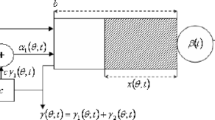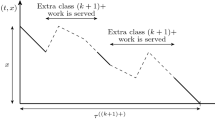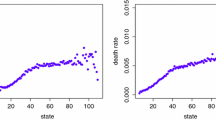Abstract
The paper gives models and analytic techniques for addressing critical issues of the Broadband Integrated Services Digital Network which will use the Asynchronous Transfer Mode. The traffic is expected to be highly bursty and variable at the source and consequently a key issue is admission control. We study a 4-parameter device called a regulator which acts as a policing device as well as a traffic shaper. The device is a generalized leaky bucket with a data buffer, a token buffer supplied by a constant-rate token stream, and a peak rate controller; the outputs of the device are streams of priority and marked cells. The composite system comprising of the source and the regulator is represented in a stochastic fluid model since fluid flow has been found to have properties well matched to the ATM environment, and the Markov Modulated Fluid Source allows bursty characteristics to be accurately modelled. A complete procedure based on spectral expansions for calculating the system's stationary state distribution is given. It is shown that with proper design the regulator effectively controls a three-way trade-off between throughput, delay and burstiness. Numerical results reveal that performance is sensitive to source characteristics such as the squared coefficient of variation of burst and silent periods. The second part of the paper characterizes the output of the regulator. The distributions of the time periods spent in the various states by the output process are calculated exactly. From this an approximate Markovian characterization is obtained. The output streams of priority and marked cells are coupled to capture their correlations. For the simple case of two-state on-off sources, the approximate Markovian characterization of the regulator's output rate processes is explicitly given and it is distinguished by the property that all moments are identical to those of the actual processes. With this characterization an original goal of analyzing a composite system of access regulation and statistical multiplexing is separated, decomposed and thereby made tractable.
Similar content being viewed by others
References
D. Anick, D. Mitra and M.M. Sondhi, Stochastic theory of a data-handling system with multiple sources, Bell Sys. Tech. J. 61 (1982) 1871–1894.
A. Berger, Overload control using rate control throttle: selecting token bank capacity for robustness to arrival rates, IEEE Trans. Aut. Cont. AC-36 (1991) 216–219.
A. Berger, Performance analysis of a rate-control throttle where tokens and jobs queue, IEEE J. Sel. Areas Commun. SAC-9 (1991) 165–170.
M.C. Chuah and R.L. Cruz, Approximate analysis of (σ, ρ) regulators,Proc. INFOCOM'90 (IEEE Computer Society Press) pp. 874–880.
C. Chamzas and D.L. Duttweiler, Encoding facsimile images for packet-switched networks, IEEE J. Sel. Areas Commun. SAC-7 (1989) 857–864.
E.G. Coffman, Jr., B.M. Igelnik and Y.A. Kogan, Controlled stochastic model of a communication system with multiple sources, to appear in IEEE Trans. Info. Theory.
J.-P. Coudreuse, G. Pays and M. Trouvat, Asynchronous transfer mode, Commutation and Transmission, no. 3 (1990) pp. 5–16.
J.N. Daigle and J.D. Langford, Models for analysis of packet voice communication systems, IEEE J. Sel. Areas Commun. SAC-4 (1986) 847–855.
L. Dittman and S.B. Jacobsen, Statistical multiplexing of identical bursty sources in an ATM network,GLOBECOM'88, pp. 1293–1297.
E.A. van Doorn and G.J.K. Regterschot, Conditional PASTA, Oper. Res. Lett. 6 (1988) 229–232.
E.A. van Doorn, A.A. Jagers and J.S.J. de Wit, A fluid reservoir regulated by a birth-death process, Comm. Statist. Stochastic Models 4 (1988) 457–472.
A.E. Eckberg, D.T. Luan and D.M. Lucantoni, Bandwidth management: a congestion control strategy for broadband packet networks — characterizing the throughput-burstiness filter, Proc. ITC Specialist Seminar, Adelaide (1989) paper no. 4.4.
A.E. Eckberg, D.T. Luan and D.M. Lucantoni, An approach to controlling congestion in ATM networks, Int. J. Digital and Analog Commun. Sys. 3 (1990) 199–209.
A.I. Elwalid and D. Mitra, Analysis and design of rate-based congestion control of high speed networks, II: statistical multiplexing, in preparation.
A.I. Elwalid, D. Mitra and T.E. Stern, Statistical multiplexing of Markov modulated sources: theory and computational algorithms,Proc. ITC-13, Copenhagen (June 1991) pp. 495–500.
D.P. Gaver and J.P. Lehoczky, Channels that cooperatively service a data stream and voice messages, IEEE Trans. Commun. COM-30 (1982) 1153–1162.
R.A. Howard,Dynamic Probabilistic Systems, vol 1: Markov Models (Wiley, New York, 1971).
J. Keilson,Markov Chain Models-Rarity and Exponentiality (Springer, New York, 1979).
F. Kishino, K. Manabe, Y. Hayashi and H. Yasudo, Variable bit-rate coding of video signals for ATM networks, IEEE J. Sel. Areas Commun. SAC-7 (1989) 801–806.
H. Kobayashi, Performance issues of Broadband ISDN,Proc. Int. Conf. on Computer Communication ICCC 90, New Delhi, pp. 349–361.
L. Kosten, Stochastic theory of data-handling systems with groups of multiple sources, in:Performance of Computer-Communication Systems, eds. H. Rudin and W. Bux (Eisevier, Amsterdam, 1984) pp. 321–331.
L. Kosten, Liquid models for a type of information buffer problems, Delft Progress Report 11 (1986) pp. 71–86.
H. Kroner, T.H. Theimer and U. Briem, Queueing models for ATM systems — a comparison,Proc. 7th ITC Specialist Seminar, Morristown (1990) paper 9.1.
P.J. Kuehn, Approximate analysis of general queueing networks by decomposition, IEEE Trans. Commun. COM-27 (1979) 113–126.
S.-Q. Li, Study of information loss in packet voice systems, IEEE Trans. Commun. COM-37 (1989) 1192–1202.
B. Maglaris, P. Anastassiou, P. Sen, G. Karlsson and J.D. Robbins, Performance models of statistical multiplexing in packet video communications, IEEE Trans. Commun. COM-36 (1988) 834–843.
D. Mitra, Stochastic theory of a fluid model of producers and consumers coupled by a buffer, Adv. Appl. Prob. 20 (1988) 646–76.
D. Mitra and I. Mitrani, Analysis of a Kanban discipline for cell coordination in production lines, I, Manag. Sci. 36 (1990) 1548–1566.
D. Mitra, I. Mitrani, K.G. Ramakrishnan, J.B. Seery and A. Weiss, A unified set of proposals for control and design of high speed data networks, this issue.
J.A.S. Monteiro, M. Gerla and L. Fratta, Leaky bucket input rate control in ATM networks,Proc. Int. Conf. Computer Communication, ICCC 90, New Delhi, pp. 370–376.
R. Nagarajan, J.F. Kurose and D. Towsley, Approximation techniques for computing loss in finite-buffered voice multiplexers, IEEE J. Sel. Areas Commun. SAC-9 (1991) 368–377.
M.F. Neuts,Matrix Geometric Solutions in Stochastic Models (John Hopkins University Press, Baltimore, 1981).
I. Norros, J.W. Roberts, A. Simonian and J.T. Virtamo, The superposition of variable bit rate sources in an ATM multiplexer, IEEE J. Sel. Areas Commun. SAC-9 (1991) 378–387.
D.W. Petr, L.A. DaSilva and V.S. Frost, Priority discarding of speech in integrated packet networks, IEEE J. Sel. Areas Commun. SAC-7 (1989) 644–656.
M. Sidi, W.Z. Liu, I. Cidon and I. Gopal, Congestion control through input rate regulation,Proc. GLOBECOM'89, Dallas, pp. 1764–1768.
T.E. Stern and A.I. Elwalid, Analysis of a separable Markov-modulated rate models for information-handling systems, Adv. Appl. Prob. 23 (1991) 105–139.
R.C.F. Tucker, Accurate method for analysis of a packet-speech multiplexer with limited delay, IEEE Trans. Commun. COM-36 (1988) 479–483.
J.S. Turner, New directions in communications (or which way to the information age?), IEEE Commun. Magazine (Oct. 1986).
A. Weiss, A new technique for analyzing large traffic systems, Adv. Appl. Prob. 18 (1986) 506–532
W. Whitt, The queueing network analyzer, Bell Sys. Tech. J. 62 (1983) 2779–2816.
G. Woodruff, R. Kositpaiboom, G. Fitzpatrick and P. Richards, Control of ATM statistical multiplexing performance,Proc. ITC Specialists Seminar, Adelaide (1989) paper 17.2.
Author information
Authors and Affiliations
Rights and permissions
About this article
Cite this article
Elwalid, A.I., Mitra, D. Analysis and design of rate-based congestion control of high speed networks, I: stochastic fluid models, access regulation. Queueing Syst 9, 29–63 (1991). https://doi.org/10.1007/BF01158791
Received:
Revised:
Issue Date:
DOI: https://doi.org/10.1007/BF01158791




